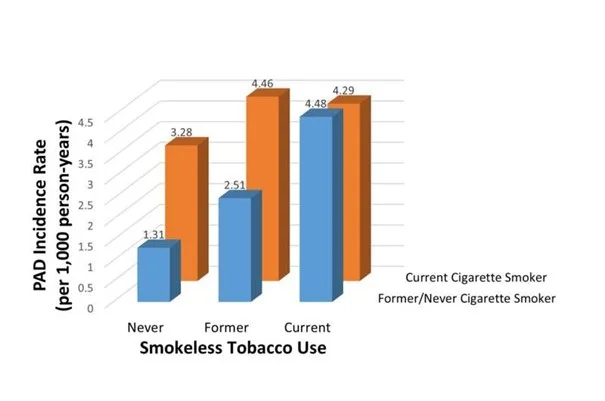- 13.04.2023
- News
Smokeless tobacco and cigarettes confer similar adverse vascular health risks
A new study in the American Journal of Preventive Medicine investigated the incidence of peripheral artery disease (PAD) among users of smokeless tobacco products. The findings show that the use of chewing tobacco and snuff is associated with a two-fold increase in the risk for PAD.

"We've long known about the link between cigarette smoking and cardiovascular disease and PAD. There is much less information available about the harmful effects of noncombustible forms of tobacco and nicotine exposure. Building on prior research associating smokeless tobacco use with heart disease and stroke, our results link use of these products to a higher incidence of PAD," explained lead investigator Jeremy R. Van't Hof, MD, MS, Lillehei Heart Institute & Cardiovascular Division, Department of Medicine, University of Minnesota Medical School, Minneapolis, MN, USA.
The investigators evaluated data from 14,344 participants in the Atherosclerosis Risk in Communities (ARIC) Study, which has followed adults in United States since the late 1980s. The average age of participants at the beginning of study was 54.1, 54.8% were female, and 26.4% were Black.
The research characterized adults by smokeless tobacco use and cigarette smoking and then analyzed who developed PAD by identifying hospitalizations with diagnosis codes for PAD or leg revascularization. After adjusting for sociodemographic and cardiovascular risk factors, smokeless tobacco use was associated with a two-fold increased risk for PAD. This increased risk was only seen in individuals who were not currently smoking at the beginning of the study.
The rate of PAD diagnoses was 4.4 per 1,000 person years among the smokeless tobacco users and 3.4 per 1,000 person years for current cigarette smokers. In comparison, there were only 1.3 cases of PAD per 1,000 person years for individuals who had never used smokeless tobacco products and were not currently smoking cigarettes.
Notably, there was no incremental increase in risk for participants who used smokeless tobacco and also smoked cigarettes. This may be because the risk of PAD from cigarette smoking is strong enough that adding an additional tobacco exposure did little to adjust that risk.
Public health efforts have successfully reduced cigarette smoking in the US over the past 30 years, but smokeless tobacco use is on the rise, with 2.4% of adults reporting use of smokeless tobacco products in 2019. Noncombustible tobacco products are often viewed as "clean" nicotine delivery systems and considered less harmful than cigarettes, leading some to advocate for their use in smoking cessation.
"While smokeless tobacco products may not expose people to the noxious effects of combustion, our study shows that they nonetheless have an adverse impact on vascular health. It is important for clinicians to understand these health implications, screen patients for all forms of tobacco and nicotine use, and counsel accordingly," Dr. Van't Hof advised.
Noting that uncertainty remains about the net benefit versus harm of vaping, he explained that the study did not evaluate e-cigarettes because the baseline ARIC data was collected before they were introduced.
More information: Jeremy R. Van't Hof et al, Association of Smokeless Tobacco Use With Incident Peripheral Artery Disease: Results From the Atherosclerotic Risk in Communities Study, American Journal of Preventive Medicine (2023). DOI: 10.1016/j.amepre.2023.01.001
Journal information: American Journal of Preventive Medicine